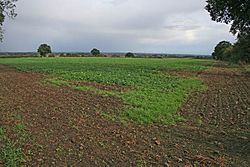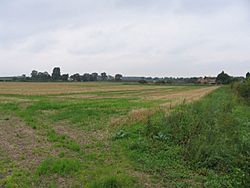Battle of Stoke Field facts for kids
Quick facts for kids Battle of Stoke Field |
|||||||
|---|---|---|---|---|---|---|---|
| Part of the Wars of the Roses | |||||||
 |
|||||||
|
|||||||
| Belligerents | |||||||
| Commanders and leaders | |||||||
Martin Schwartz † |
|||||||
| Strength | |||||||
| 12,000 | 8,000 | ||||||
| Casualties and losses | |||||||
| 300–3,000 | 4,000 | ||||||
The Battle of Stoke Field was fought on 16 June 1487. Many people consider it the very last battle of the Wars of the Roses. This was a long series of fights between two powerful families, the Lancastrians and the Yorkists, who both wanted to rule England.
Two years before Stoke Field, the Battle of Bosworth Field had put King Henry VII on the throne. This ended the rule of the Yorkist family and started the Tudor family's time as kings and queens. However, some Yorkist leaders still wanted to remove Henry VII. The Battle of Stoke Field was a big fight where they tried to do this, supporting a young man named Lambert Simnel who pretended to be a prince.
This battle is sometimes seen as less important than other Wars of the Roses battles. But it might have been even bigger than Bosworth, with many more soldiers getting hurt. The land where they fought made the armies clash very closely. In the end, King Henry won a huge victory. Almost all the main Yorkist leaders were killed during the battle.
Contents
Who Fought in This Battle?
King Henry VII was the new ruler of England. He belonged to the House of Tudor. He tried to make the Yorkist family happy by marrying Elizabeth of York, who was their princess. But his power was not completely safe.
The main person who could claim the throne for the Yorkist family was Edward, Earl of Warwick. He was the queen's cousin and was kept locked up in the Tower of London.
A young man named Lambert Simnel started pretending to be Edward, Earl of Warwick. A priest named Richard Symonds helped him. John de la Pole, Earl of Lincoln, a Yorkist leader, became interested in Simnel. Lincoln himself had a claim to the throne. The previous king, Richard III of England, who was a Yorkist, had named Lincoln as his heir. Lincoln likely knew Simnel was not the real prince, but he saw a chance to get revenge and power.
Lincoln left England on 19 March 1487. He went to Mechelen (Malines) to visit his aunt, Margaret, Duchess of Burgundy. Margaret was a strong supporter of the Yorkist cause. She gave Lincoln money and soldiers. These were 2,000 German and Swiss fighters led by a skilled commander named Martin Schwartz. Other English rebel lords joined Lincoln in Mechelen. These included Lord Lovell and Sir Richard Harleston. The Yorkists decided to sail to Ireland, where many people still supported the Yorkist family. They hoped to find more soldiers there.
The Yorkist Plan
The Yorkist ships sailed to Dublin, Ireland, arriving on 4 May 1487. With help from powerful Irish nobles like Gerald FitzGerald, 8th Earl of Kildare, Lincoln gathered more soldiers. He recruited 4,500 Irish fighters. Most of these were kerns, who were lightly armored but very fast foot soldiers.
With the support of Irish nobles and church leaders, Lincoln had Lambert Simnel crowned "King Edward VI" in Dublin on 24 May 1487. Even though a Parliament was planned for the new "King," Lincoln did not want to stay in Dublin. Instead, he quickly gathered his army and Simnel and sailed to northern Lancashire in England.
Marching Through England
When they landed on 4 June 1487, more English nobles joined Lincoln. These were led by Sir Thomas Broughton. The Yorkist army, now about 8,000 strong, marched very quickly. They covered over 200 miles in just five days. On the night of 10 June, near Tadcaster, Lord Lovell led 2,000 men in a surprise attack. They fought 400 Lancastrian soldiers led by Lord Clifford. The Yorkists won a huge victory.
Lincoln then tricked King Henry's northern army. This army was led by the Earl of Northumberland. Lincoln sent a small group of soldiers to attack Bootham Bar in York on 12 June. This made Northumberland's army go north to defend York.
Lincoln and his main army continued marching south. Outside Doncaster, Lincoln met some of King Henry's horse soldiers. These were led by Edward Woodville, Lord Scales. For three days, there were small fights through Sherwood Forest. Lincoln pushed Scales's soldiers back to Nottingham. Scales's cavalry waited there for the main royal army. However, these fights slowed down the Yorkist army. This gave King Henry time to get many more soldiers. Lord Strange brought reinforcements. Rhys ap Thomas, a key supporter of Henry from Wales, also arrived with more men.
King Henry's army now had more soldiers than the Yorkists. His army was also "much better armed and equipped." Henry's two main military leaders, Jasper Tudor and John de Vere, 13th Earl of Oxford, were also more experienced than the Yorkist commanders.
The Battle Begins
On 15 June, King Henry started moving north-east towards Newark. He had heard that Lincoln's army had crossed the River Trent. Around 9 AM on 16 June, King Henry's first soldiers met the Yorkist army. These first troops were led by the Earl of Oxford. The Yorkist army was gathered together on a hill called Rampire Hill. This hill was surrounded on three sides by the River Trent, near the village of East Stoke. Their right side was on a high spot called Burham Furlong.
King Henry's army was split into three main groups. Oxford led the first group. Just like at Bosworth, the King let Oxford lead the actual fighting. Before the battle, some strange lights in the sky made some of Henry's soldiers worried. A few even ran away. But Oxford and other nobles were able to make the soldiers feel brave again. Soon, the army was ready to fight.
A Tough Fight
The Yorkists were in one strong group. King Henry's soldiers shot many arrows at them. To escape the arrows, the Yorkists decided to attack right away. They hoped to break through Henry's lines and defeat his army quickly. Even though they had fewer soldiers overall, the Yorkists had a strong group of "well-trained foreign mercenaries." Their concentrated attack was bigger than Oxford's first group of soldiers.
Oxford's group was badly shaken, but he managed to get his soldiers back in order. The battle was very fierce and lasted for over three hours. But the Yorkists could not break Henry's lines early on. Slowly, they started to lose strength. Henry chose not to send in his other groups of soldiers. He left the fighting to Oxford's group. This group was probably given more soldiers as other Lancastrian groups arrived, guided by Jasper Tudor.
The German mercenaries had the newest handguns. But King Henry's army had many skilled archers with longbows. These archers could shoot many arrows very quickly. The Irish soldiers in the Yorkist army did not have much armor. This meant they were hit by more and more arrows.
The German and Swiss mercenaries could not retreat because the river was on three sides. They fought until the end. One writer, Jean Molinet, said they were "filled with arrows like hedgehogs." The defeated Yorkist soldiers ran towards the Trent. Many were trapped and killed in a deep ditch, which people still call the Bloody Gutter today. Most of the Yorkist leaders, including Lincoln, Fitzgerald, and Schwartz, died fighting. Only Lord Lovell and Broughton might have escaped. Lord Lovell disappeared after the battle and was never seen again. Some think he went to Scotland. Later, in the 1700s, a body was found in a secret room at his house. People wondered if it was him.
What Happened After the Battle?
Lambert Simnel was captured. But King Henry pardoned him. This was a kind act that made Henry look good. Henry knew that Simnel was just a puppet for the Yorkist leaders. Simnel was given a job in the royal kitchen. Later, he was promoted to a falconer, someone who trains birds for hunting. The Irish nobles who had helped Simnel were also pardoned. Henry believed he needed their support to rule Ireland well. However, Henry later asked the Pope to punish the Irish church leaders who had supported the rebellion.
Two other Yorkist plotters were also caught. These were Richard Symonds, the priest who introduced Lincoln to Simnel, and John Payne, the Bishop of Meath. Payne had given the speech at Simnel's crowning. Neither of them were executed. Symonds was put in prison. Payne was pardoned and later got back into the King's favor.
To celebrate his victory, Henry put his flag on Burham Furlong. A large stone marks the spot today. It says, "Here stood the Burrand Bush planted on the spot where Henry VII placed his standard after the Battle of Stoke 16 June 1487." Henry made many of his supporters knights after the battle. A list of these new knights, written by John Writhe, still exists. Thirteen new bannerets (a special type of knight) were created, and 52 men became knights.
Henry had hoped to capture Lincoln alive. He wanted to learn how much support the Yorkists still had. Instead, Henry started many investigations. The result was "relatively few executions and very many fines." This fit Henry's plan to control the rich nobles by making them less wealthy. After the battle, he traveled north through Pontefract, York, Durham, and Newcastle. He wanted to show himself in the areas that had strongly supported Richard III.
Later in Henry's time as king, in the 1490s, another person pretended to be a prince. This was Perkin Warbeck. But this time, the problem was solved without another big battle like the Battle of Stoke Field.
Images for kids
See also
 In Spanish: Batalla de Stoke Field para niños
In Spanish: Batalla de Stoke Field para niños






